
More and more people suffer from skin cancer, so this disease is much spoken about. However, it is important to distinguish between truth and fiction, and here are 5 most enduring myths about skin cancer.
All types of skin cancers are identical
This is completely untrue! For example, basal cell carcinoma is the most common type of skin cancer, and, fortunately, the least dangerous one. Squamous cell carcinoma is less common, but it can be deadly. It is this kind of skin cancer that is the cause of every fourth death from the disease. The least common, but most dangerous is malignant melanoma. By the way, the people who have already faced basal cell or squamous cell carcinoma are two to three times more likely to get melanoma.
Sunscreens are not safe
Sunscreens are one of the most effective ways of protection from skin cancer that is known to be caused by UV radiation. Recently there has been a lot of dispute about whether they include hazardous to health components. However, experts have found that these ingredients do not penetrate the skin and do not bring us any harm.
Solarium has become safer
In solariums, we get 3-5 times higher dose of ultraviolet radiation than in the sun. Although the new generation of solariums is really somewhat less dangerous than the older one, they can still be a cause of skin cancer.
What about vitamin D?
Some people quite rarely happen to be in the sun because of their living area, low mobility, or the elderly age; others cover the whole body with clothing for religious reasons. These people may face serious problems related to bones because their body does not get vitamin D, which is produced by the sun. Therefore, we need to stay in the sun, but not much; at the same time it is necessary to protect the skin with creams.
I’m safe in the shadow
Shadow is great, but sometimes it causes a false sense of security. Scattered UV radiation exceeds about half of the radiation which we are exposed to on a sunny day. Shadow protects against direct ultraviolet radiation (the other half), but when direct sunlight is blocked, we receive the UV dose just reduced by half, so it does not mean that we are fully protected.






